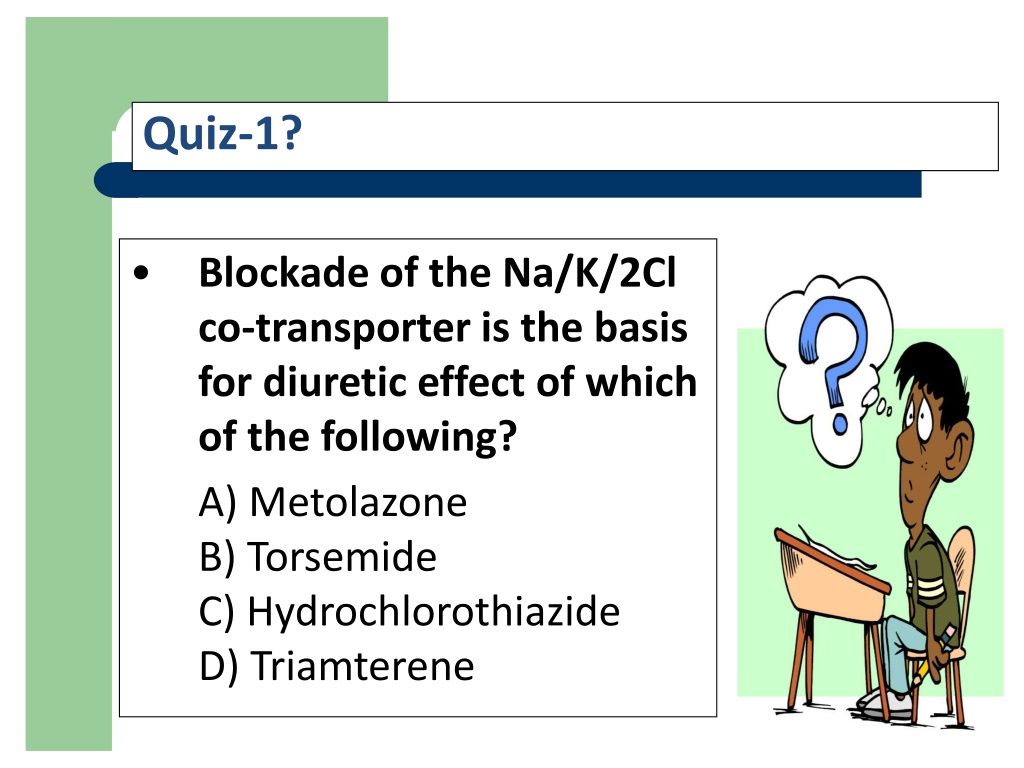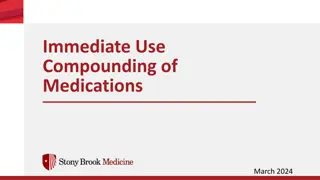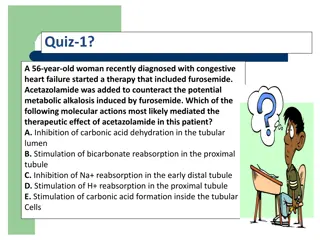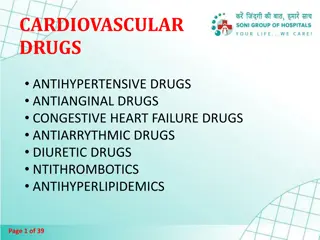Diuretic Mechanisms and Medications: Quiz Questions and Answers
Explore a series of quiz questions focusing on diuretic medications, their mechanisms of action, and clinical scenarios. Topics include the diuretic effects of specific medications, management of idiopathic hypercalciuria, drug interactions in elderly patients, effects of loop diuretics on ionic excretion, and the selection of diuretic therapy in heart failure cases. Enhance your knowledge of diuretics and their applications in clinical practice through these engaging quiz scenarios.
Download Presentation

Please find below an Image/Link to download the presentation.
The content on the website is provided AS IS for your information and personal use only. It may not be sold, licensed, or shared on other websites without obtaining consent from the author. Download presentation by click this link. If you encounter any issues during the download, it is possible that the publisher has removed the file from their server.
E N D
Presentation Transcript
Quiz-1? Blockade of the Na/K/2Cl co-transporter is the basis for diuretic effect of which of the following? A) Metolazone B) Torsemide C) Hydrochlorothiazide D) Triamterene
Quiz-2? A-7- year old boy is brought to the clinic by his mother. He complains of sharp pain in his flanks as well as dysuria and frequency. The doctor orders a 24-hour urine calcium test, and the results come back abnormal. The child was diagnosed with idiopathic hypercaliuria. What type of medication is used for this disorder? A) mannitol B) hydrochlorothiazide C) amiloride D) spironolactone
Quiz-3? An 87-year-old female who is taking multiple medications for her heart disease is prescribed gentamicin for diverticulitis. After a few days of taking the antibiotic, she complains of dizziness and tinnitus. What heart medication might she be on? A) spironolactone B) hydrochlorothiazide C) ethacrynic acid D) amiloride
Quiz-4? Which of the following is an action of loop diuretics on ionic excretion? A) Increased sodium excretion B) Decreased magnesium loss C) Decreased calcium loss D) Decreased potassium loss
Quiz-5? A 35-year-old woman presents to your office for a regular check-up. She has no complaints. On examination, her blood pressure is slightly elevated at 145/85. She is physically fit and follows a healthy diet. You decide to start her on antihypertensive therapy and prescribe hydrochlorothiazide. How does this agent work? (A) Inhibits reabsorption of sodium chloride in the early distal convoluted tubule (B) Decreases net excretion of chloride, sodium, and potassium (C) Increases excretion of calcium (D) Inhibits reabsorption of sodium chloride in the thick ascending limb of the loop of Henle (E) Interferes with potassium secretion
Quiz-6? A 57-year-old man with a history of heavy alcohol use is being admitted for a first episode of congestive heart failure , which likely resulted from untreated alcoholic cardiomyopathy. The cardiologist decides to start the patient on diuretic therapy. Which class of diuretics is preferred in this case? (A) Loop diuretics, because they exert their action at the distal convoluted tubule (B) Loop diuretics, because the thick ascending limb is an area of high capacity for NaCl reabsorption (C) Thiazide diuretics, because they exert their action at the thick ascending limb of the loop of Henle (D) Thiazide diuretics, because they increase cardiac output (E) Thiazide diuretics, because they increase peripheral vascular resistance
Quiz-7? A 75-year-old woman with hypertension is being treated with a thiazide. Her blood pressure responds well and reads at 120/76 mm Hg. After several months on the medication, she complains of being tired and weak. An analysis of the blood indicates low values for which of the following? A. Calcium. B. Glucose. C. Potassium. D. Uric acid.
Quiz-8? A new diuretic is being studied in human volunteers. Compared with placebo, the new drug increases urine volume, increases urinary Ca2+, increases plasma pH, and decreases serum K+. If this new drug has a similar mechanism of action to an established diuretic, it probably A. blocks the NaCl cotransporter in the DCT B. blocks aldosterone receptors in the CT C. inhibits carbonic anhydrase in the PCT D. inhibits the Na+/K+/2Cl cotransporter in the TAL E. acts as an osmotic diuretic
Quiz-9? A 71-year-old man with chronic renal failure with edema has been titrated up to the maximal single daily dose of bumetanide, but he still has significant edema. What option should initially be considered to reduce the edema? A- Increase the single dose of bumetanide above the ceiling dose B- Increase the frequency of dosing of bumetanide C -Add a K+ sparing diuretic D- Add a thiazide diuretic E- Begin IV infusion of bumetanide
Quiz-10? When furosemide is administered to a patient with pulmonary edema, there is often symptomatic relief within 5 minutes of starting treatment. This relief is primarily due to: (A) A rapid diuretic effect (B) An increase in venous capacitance (C) A direct effect on myocardial contractility (D) Psychological effects























